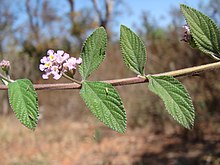Lippia is a genus of flowering plants in the verbena family, Verbenaceae. It was named after Augustin Lippi (1678–1705), a French naturalist and botanist (with Italian origins). He was killed in Abyssinia. The genus contains roughly 200 species of tropical shrubs that are found around the world. Plants are fragrant due to their essential oils, which vary between species but may include estragole, carvacrol, linalool or limonene. The leaves of certain species, such as L. graveolens, can be used as a culinary herb similar to oregano.[3]
| Lippia | |
|---|---|

| |
| Lippia alba | |
| Scientific classification | |
| Kingdom: | Plantae |
| Clade: | Tracheophytes |
| Clade: | Angiosperms |
| Clade: | Eudicots |
| Clade: | Asterids |
| Order: | Lamiales |
| Family: | Verbenaceae |
| Genus: | Lippia L. |
| Type species | |
| Lippia americana L.[1]
| |
| Species | |
|
See text | |
| Synonyms[2] | |
|
ZapaniaLam. | |
Selected species
edit- Lippia abyssinica (Otto & A.Dietr.) Cufod.[4] – Ethiopia
- Lippia alba (Mill.) N.E.Br. ex Britton & P.Wilson – Bushy lippia, white lippia (United States (Texas), Mexico, the Caribbean, Central America, and South America)[3]
- Lippia carterae (Moldenke) G.L.Nesom – Licorice verbena (Baja California, Mexico)[3]
- Lippia durangensis Moldenke
- Lippia graveolens Kunth – Mexican oregano, scented lippia, scented matgrass (Southwestern United States, Mexico, and Central America as far south as Nicaragua)
- Lippia javanica (Burm.f.) Spreng.
- Lippia kituiensis Vatke
- Lippia micromera Schauer – Spanish thyme (Central America, the Caribbean, and northern South America)[3]
- Lippia multiflora Moldenke
- Lippia myriocephala Schltdl. & Cham.
- Lippia palmeri S.Watson
- Lippia pretoriensis H.Pearson
- Lippia rehmannii H.Pearson
- Lippia salicifolia Andersson (Ecuador)
- Lippia scaberrima Sond.
- Lippia sidoides Cham.[5][6]
- Lippia substrigosa Turcz.
- Lippia thymoides Mart. & Schauer
Formerly placed here
edit- Aloysia citrodora Palau (as L. citrodora Kunth or L. triphylla (L'Hér.) Kuntze)
- Aloysia lycioides Cham. (as L. lycioides (Cham.) Steud.)
- Aloysia scorodonioides (Kunth) Cham. (as L. scorodonioides Kunth or L. wrightii A.Gray ex Torr.)
- Lantana montevidensis (Spreng.) Briq. (as L. montevidensis Spreng.)
- Lantana ukambensis (Vatke) Verdc. (as L. ukambensis Vatke)
- Mulguraea ligustrina (Lag.) N.O'Leary & P.Peralta (as L. ligustrina (Lag.) Britton)
- Phyla canescens (Kunth) Greene (as L. canescens Kunth or L. filiformis Schrad.)
- Phyla cuneifolia (Torr.) Greene (as L. cuneifolia (Torr.) Steud.)
- Phyla dulcis (Trevir.) Moldenke (as L. dulcis Trevir.)
- Phyla lanceolata (Michx.) Greene (as L. lanceolata Michx.)
- Phyla nodiflora (L.) Greene (as L. nodiflora (L.) Michx. or L. repens Spreng.)
- Phyla stoechadifolia (L.) Small (as L. stoechadifolia (L.) Kunth)[5]
References
edit- ^ "Lippia L." TROPICOS. Missouri Botanical Garden. Retrieved 2009-12-02.
- ^ "Genus: Lippia L." Germplasm Resources Information Network. United States Department of Agriculture. 1996-09-17. Retrieved 2010-01-21.
- ^ a b c d Tucker, Arthur O.; Thomas DeBaggio (2009). The Encyclopedia of Herbs: A Comprehensive Reference to Herbs of Flavor and Fragrance (2 ed.). Timber Press. pp. 297–300. ISBN 978-0-88192-994-2.
- ^ "World Checklist of Selected Plant Families: Royal Botanic Gardens, Kew". Board of Trustees of the Royal Botanic Gardens, Kew. Retrieved 2017-08-01.
- ^ a b "GRIN Species records of Lippia". Germplasm Resources Information Network. United States Department of Agriculture. Archived from the original on 2012-12-11. Retrieved 2010-09-13.
- ^ "Lippia". Integrated Taxonomic Information System. Retrieved 21 January 2010.
Wikispecies has information related to Lippia.